- Submissions

Full Text
Determinations in Nanomedicine & Nanotechnology
Role of Graphene Nano-Dots (GDs) in Developing and Efficiency of Solar Cells
Omid Ashkani*
Department of Materials Science and Engineering, Faculty of Engineering, Science and Research branch, Azad University, Iran
*Corresponding author:Omid Ashkani, Department of Materials Science and Engineering, Faculty of Engineering, Science and Research branch, Azad University, Iran
Submission: June 26, 2024;Published: July 05 , 2024

ISSN: 2832-4439 Volume3 Issue 3
Graphene one of the amazing materials is researched by researchers due to its high conductivity, high absorption coefficient and desirable physical properties. In current research, by applying graphene on the solar cell surfaces, the characteristics of the cell were investigated. The results showed that with this method, the fill factor coefficient of the solar cell increases between 6 and 15.3%. Also, the measurement of illuminance changes showed that the presence of graphene increases the illuminance by 21.2%, which is a significant growth.
Keywords:Graphene Nano-Dots; Solar cell; Fill factor; Illuminance
Introduction
Today, the development of graphene quantum dots and graphene Nano-particles in various industries, including the manufacture of medical parts [1], detectors [2] and solar cells [3,4], is of great interest to researchers. In the meantime, due to the strong need of mankind for the use of clean energy, graphene plays a brilliant role in the development of solar cells. The results of previous research show that solar cell design with graphene can increase the efficiency of deep energy conversion by 30.8% [5]. Also, by using titanium with oxide-graphene solar cells, the fill factor coefficient can be increased up to 73.4% [6]. The results also show the importance of new methods in making these cells. A combination of Li+GO can also increase the fill factor up to 70.3% [7]. According to this brief introduction, the development of solar cells with graphene particles still needs further investigation. The methods of applying Nanoparticles on surfaces should be investigated and its effects on performance parameters such as illuminance and the like should be analyzed. In the continuation of the current research, the cases will be examined.
Material and Methods
Figure 1:A view of the solar cell used in the present study.
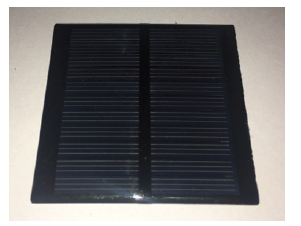
In the present study, a poly-crystalline silicon and photovoltaic solar cell was used to investigate the efficiency of the solar cell. Figure 1 shows a view of the solar cell. In order to increase light absorption, an anti-reflection layer was created on the cell. After preparing the solar cell, in order to apply graphene Nano-particles, the Nanoparticles were first dissolved in ethanol solution. A magnetic stirrer was used for complete solution and uniformity of the solution and the solution was stirred for 90±1 minutes. Figure 2 shows the dimensions of graphene powder and graphene layers before dissolving in the solution. The interconnected layered sheets of graphene are evident in the Figure 2.
Figure 2:SEM micrograph of graphene before dissolved in ethanol.
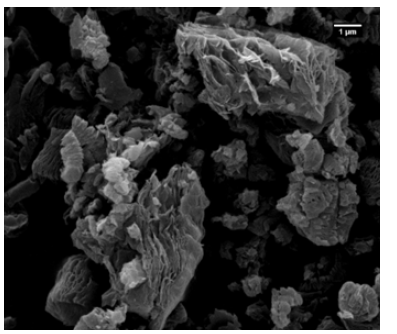
After solubilization, the desired solution was applied on the surface of the solar cell at ambient temperature and pressure. After applying the solution, the cell was heated at a temperature of 82±2 degrees Celsius so that the graphene dots remain on the surface and the ethanol evaporates. In order to check the efficiency of the solar cell, before applying the graphene nanoparticles, the cell took on the task of turning on a 3-W COB lamp. The fill factor and the length of time the lamp stays on before applying graphene nanoparticles were measured. Then, after applying the nanoparticles, the test parameters were measured again and compared with the initial conditions. It should be noted that for further investigation, the deposition of graphene dots was repeated five times with the mentioned method. This action leads to the creation of a layer of graphene, which causes changes in cell function. It should be noted that after applying a layer with the mentioned method, the tests were repeated and the results were recorded.
Results and Discussion
Figure 3 shows the XRD analysis of the surface after the process. In the XRD pattern graphite peak in 26.22, 44.36 and 83.16 - 2θ were observed. Also, the Si peak was observed in 8.19-2θ. Of course, it should be noted that due to the use of ethanol, peaks of hydrogen are detected at 26.07-2θ, which overlap with graphite. The presence of graphite is a confirmation of the existence of the layer on the surface. Figure 4 shows the results of the FF (Fill Factor) coefficient after applying each layer of graphene dots and without applying the layer. This coefficient is one of the most important coefficients in solar cell performance [8]. As it is known, by increasing the number of graphene layers, the fill factor has increased until the maximum performance is achieved after 4 layers. However, it should be noted that after applying 5 layers and repeating 5 steps, the coefficient has decreased and probably due to the increase of layers, the efficiency has decreased slightly. Of course, in the end, the FF coefficient is still increasing compared to the case where no layer is applied, and this is a sign of improved cell performance. Of course, it has been observed in some researches that with the increase of graphene layers, FF coefficient continues to increase [9] which is due to the difference in the methods of applying graphene. The current research method is considered as a simple and economic method.
Figure 3:XRD pattern after process.
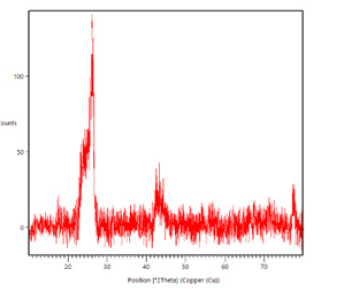
Figure 4:Effect of graphene layer number on FF factor.
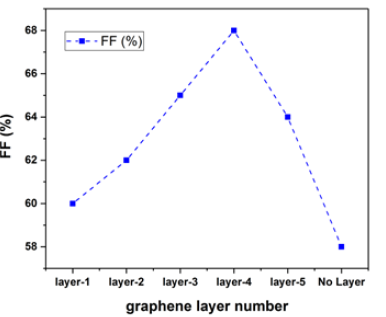
Figure 5 shows the comparison of the lifespan of the light for COB lamp in different situations. As can be seen, after applying the first layer, the lamp’s duration stays on has increased by 6% and this amount increases to 15.3% in the fourth layer. It should be noted that these numbers are practically measured. Obviously, the presence of graphene increases light absorption and conductivity [10] and therefore leads to an increase in efficiency in keeping the lamp on, which is considered as a desirable result. Finally, Figure 6 shows the illuminance in different situations. Lutron LX 1118 digital light meter was used to measure light intensity (illuminance). The light intensity is directly related to the power generated in the cell, as the results show, with the increase in the number of graphene layers, the illuminance has increased from 182 to 231 Lux. Similar results have been shown in the field of quantum efficiency of graphene dots in previous researches. The results show that the quantum efficiency also increases from 0.2 to 3.62 [11], which is similar to this issue in the present study. Since graphene has a quantum behavior in the nanoscale, this behavior leads to an increase in efficiency and, as a result, an increase in illuminance.
Figure 5:Effect of Graphene Layer Number on lifespan of the light.
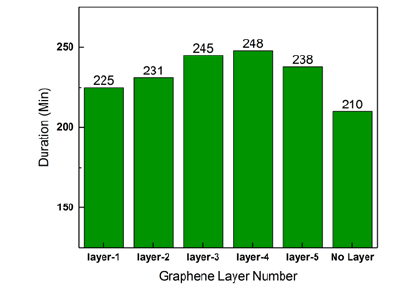
Figure 6:Effect of Graphene Layer Number on illuminance.

Conclusion
In general, graphene as one of the new materials plays a very
effective role in the development of solar cells. In the current
research, with a simple and economical method, graphene Nanoparticles
were applied on the surface and after creating different
layers, the optical and physical properties were investigated. In
general, the results have shown that:
A. Graphene plays an effective role in increasing the FF
coefficient of solar cells and can increase this coefficient by
15%.
B. The presence of graphene increases the illuminance and
this issue has an effective role in the efficiency of the cell.
C. The graphene plays an effective role in the length of time
the lamp stays on and the efficiency of the cell increases.
D. It is suggested that in the future, researchers should
provide more research by applying graphene quantum dots and
analyzing the above parameters again.
References
- Ashkani O, Sadeq AM (2024) Advancements in biomaterials development using graphene quantum dots: A mini review. Significances of Bioengineering & Biosciences 7(1): 743-745.
- Sheikh Mohd Ghazali SAI, Fatimah I, Zamil ZN, Zulkifli NN, Adam N (2023) Graphene quantum dots: A comprehensive overview. Open Chemistry 21(1): 20220285.
- Ashkani O, Abedi-Ravan B, Yarahmadi Y (2024) Recent advances in the development of quantum materials for the construction of solar cells: A mini review. Journal of Environmental Friendly Materials 1(8): 67-75.
- Zhang Y, Tang Q, He B, Yang P (2016) Graphene enabled all-weather solar cells for electricity harvest from sun and rain. Journal of Materials Chemistry A. 4(34): 13235-13241.
- Narayanaswamy G, Mruthunjaya RH, Rakshith LA, Keerthinath V, Santhosh (2021) Design of graphene-based solar cell. International Research Journal of Modernization in Engineering Technology and Science 3(7): 228-232
- Chen L, Zhou Y, Tu W, Li Z, Bao C, et al. (2013) Enhanced photovoltaic performance of a dye-sensitized solar cell using graphene–TiO 2 photoanode prepared by a novel in situ simultaneous reduction-hydrolysis technique. Nanoscale 5(8): 3481-3485.
- Agresti A, Pescetelli S, Cinà L, Konios D, Kakavelakis G, et al. (2016) Efficiency and stability enhancement in perovskite solar cells by inserting lithium‐neutralized graphene oxide as electron transporting layer. Advanced Functional Materials 26(16): 2686-2694.
- Qi B, Wang J (2013) Fill factor in organic solar cells. Physical Chemistry Chemical Physics 15(23): 8972-8982.
- Li X, Zhang S, Wang P, Zhong H, Wu Z, et al. (2014) High performance solar cells based on graphene-GaAs heterostructures. arXiv preprint arXiv:1409.350
- Apell Peter , Hanson G, Hägglund Carl (2012) High optical absorption in graphene.
- Dong P, Jiang BP, Liang WQ, Huang Y, Shi Z, et al. (2017) Synthesis of white-light-emitting graphene quantum dots via a one-step reduction and their interfacial characteristics-dependent luminescence properties. Inorganic Chemistry Frontiers 4(4): 712-718.
© 2024 Omid Ashkani*. This is an open access article distributed under the terms of the Creative Commons Attribution License , which permits unrestricted use, distribution, and build upon your work non-commercially.
 a Creative Commons Attribution 4.0 International License. Based on a work at www.crimsonpublishers.com.
Best viewed in
a Creative Commons Attribution 4.0 International License. Based on a work at www.crimsonpublishers.com.
Best viewed in 







.jpg)






























 Editorial Board Registrations
Editorial Board Registrations Submit your Article
Submit your Article Refer a Friend
Refer a Friend Advertise With Us
Advertise With Us
.jpg)






.jpg)














.bmp)
.jpg)
.png)
.jpg)










.jpg)






.png)

.png)



.png)






